The Oldest Profession in the World? by Dr Kate Lister, Researcher at Leeds Trinity University.
Special cover feature for Live Encounters Magazine July 2017
Dr. Kate Lister is a researcher at Leeds Trinity University in historical attitudes to sexuality and sex work. She is the curator of the online project and popular Twitter account @WhoresofYore where she tweets the history of illicit sex and works to promote sex worker rights and challenge stigma to over 82,000 followers. The Whores of Yore project is unique in its aims to create a space for academics, artists, sex workers and activists to collect their research. Kate is on the board of the international sex work research hub, works with local charities who support sex workers in the UK. Kate has published on the history of media narratives around sex work, the history of menstruation and sexual violence in historical dramas.
———————–
‘Prostitution is the oldest profession is the world’. You heard that one before, right? This article is going to examine that claim, but before we go any further I want you to just close your eyes and imagine what a ‘prostitute’ looks like. You don’t have to describe this to anyone, it’s just for you. Picture that person in your mind and think of some words you associate with this mental image.
………
I don’t know what you thought of, but I know that I did this experiment with a group of my students and set up an anonymous online poll for them to respond to. This is a sample of the results.
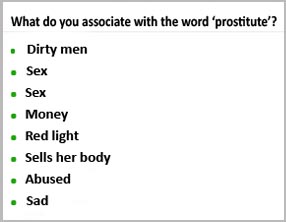
Now, it’s not that these students are particularly hostile to sex work, but these seem to be words we associate with ‘prostitute’. Maybe you were different – I hope so. The reason sex workers resist the word ‘prostitute’ is because of what we associate with it. It’s a word burdened with considerable cultural baggage, none of it positive. When we think of a ‘prostitute’, we think of someone ‘other’ to us. As this brief poll shows, we think we have a very clear idea of what a prostitute is. But what happens when we look backwards to try and find this figure? The biggest challenge facing sex worker rights activists is stigma, and all the research show us that this damaged view of the ‘prostitute’ is far from the truth, yet we persist in trying to identify this figure throughout history.
Despite the old adage, sex work is not the world’s oldest profession in the world: medicine is. Anthropologist George Peter Murdock of Yale University, researched the social customs of numerous of tribes around the world, and found that prostitution did not exist in many, so called, primitive societies but the medicine man was universal (Murdock, 1952). Others, such as Mary Breckinridge, have suggested that midwifery is the oldest profession; ‘The midwife’s calling is so ancient that the medical and nursing professions, in even their earliest traditions, are parvenus beside it’ (Breckinridge, 1927). Trying to work out what is the ‘oldest’ profession is actually something of a wild goose chase as professions, and indeed money, are quite recent inventions. Homo sapiens have been wandering around the planet for about 200,000 years and the earliest evidence of coined money dates to 640BC in Lydia, Asia Minor. Even systems of bartering goods, rather than money, depend largely on the domestication of cattle and cultivation of crops, and that dates to around 9000BC (Davies, 2002). This means that for most of human history, we have done without money. Food grows naturally all over the planet, water falls from the sky and animals are as tasty as they are lovely – we do not actually need money. Given that money is arguably the most dominating influence in how we live our lives, it is sobering to remember that the only value money actually has is that which we collectively attach to it. Ultimately, its pieces of paper and discs of metal that we have all agreed are special. We managed perfectly well without it until our ancestors thought that those gold rocks were nicer to look at than the other rocks (but, I digress).

Simply put, without money and commerce there is no need for professions. There would certainly have been roles and responsibilities within social groups (like the midwife and the medicine man), but, despite what the Flintstones taught us, paid ‘jobs’, as we would have recognised them, were not part of prehistory. This is also true of many cultures that don’t use money. There is no evidence of selling sex among the Māori before Europeans arrived in New Zealand carrying with them syphilis and flags. Kammerer, et al. notes that, originally, the northern hill tribes of Thailand had no word for prostitution. Victorian explorers were surprised to discover that the Dyak people of Borneo had ‘no word to express that vice’. When the Christian missionary, Lorrin Andrews, translated the bible into Hawaiian in 1865, he had to invent new words to teach the islanders about the concept of sexual shame, and infidelity (Kammerer et al., 1995; Ruuskanen, 1993, Sanger, 1859).
There is very little evidence of prostitution among the native Americans until the Europeans turned up to ‘civilise’ everyone. Even then, the only evidence that exists is that the invaders believed all indigenous women were promiscuous (Bakken and Farrington, 2003). The commodification of sex, and selling of sexual favours as a profession, is firmly linked to the establishment of money and economic markets. The causal effect of establishing commerce with the selling of sex was seen in a pioneering experiment by Yale economist, Keith Chen. In 2006, Chen introduced the use of currency, to a group of Capuchin monkeys, and taught them to buy grapes, jelly and apples with tokens: the female monkeys began trading sex for money almost immediately (Keith Chen, et al., 2006).
Of course, an absence of money doesn’t mean that our ancestors cavorted in a cash free Eden, having guilt free sex in a state of moral innocence – of course they traded sexual favours. We are hardwired to want sex, and that gives it its own value. Sex work may not be the oldest profession, but sex is surely one of the oldest currencies? Humans are animals after all. We like to think of ourselves as the cleverest of all the animals (we have Sudoku and university Challenge) but when it comes to instinct, we’re just horny, hungry chimps with better options. What’s more, humans aren’t the only animals that trade sex. In 2007, Michael D. Gumbert published a paper reporting that longtailed male macaques traded grooming to have sex with females (Gumert, 2007). A sort of monkey equivalent of Netflix and chill. Not only were macaques trading sex, but Gumbert observed market forces at work. The currency paid by the males was the length of time spent grooming the female before sex, and the price rose and fell with the availability of females. The more females available, the less males paid for sex, and visa versa. Availability was not the only market force witnessed, females that were highly ranked within the group commanded higher prices and were groomed for longer (Gumert, 2007).

Dr Fiona Hunter, a Cambridge University Zoologist, observed that female Adelie Penguins on Ross Island in Antarctica traded sex for rocks (Hunter, 1998). Penguins use rocks to build a platform for their nests, which keeps their eggs off the ice. So valuable are the rocks, that penguins will steal them and get into fights. When the females want to take rocks from male counterparts, they trade sex. Adelie Penguins chose one mate, so all this rock business is extra sneaky. The female approaches a male with the rocks she wants and engages him in a mating dance. Once they have had sex, the she takes the rocks and returns to her mate (who is none the wiser). Dr Hunter recorded several incidents of females ‘cheating’ men out of their rocks by presenting themselves for mating, then stealing his rocks and running away without ever having sex (BBC, 1998). This behaviour is highly significant as it reveals that sex work might not be the result of economic and social factors. Trading sex is not even unique to humans; sex is its own currency.
Virginia Henley once wrote “we’re all whores under the skin, whether we give ourselves by calculation or by desire. It’s just that some of us demand a higher price than others” (Henley, 2009). Perhaps you’re reading this and are shouting at the screen ‘I am not a slutty penguin! I have never used sex as payment!’ But, research shows that we all trade on sex to some extent. I am not talking about waggling your genitals at rock merchants. I am talking about the bubbling, unspoken, cracklings of sexual energy that fizz between us all every day, that are routinely manipulated, exploited and used for personal gain. Fine. You’ve never found yourself a few quid short and offered to fellate a barista in return for an iced mocha and a mini muffin, but we all know the value of being sexually attractive – and very few of us are above caring about how we appear to others. If you’ve never batted your eyelids or undone that top button to get your own way; or employed the 25-year-old male model to do your taxes, when the only qualification he had was tussled hair and the calculator on his iphone (just me?) then good for you. But all the research shows us that however un PC we know it to be, we’re nicer to people we fancy, and that behaviour is guided by sexual instinct.
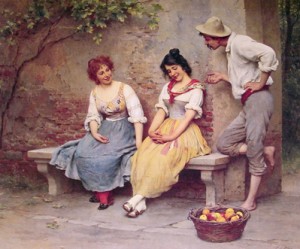
Professor Catherine Hakim called this ‘erotic capital’ and argued that ‘meritocracies are supposed to champion intelligence, qualifications, and experience. But physical and social attractiveness deliver substantial benefits in all social interaction… (Hakim, 2011). Numerous studies have also shown that attractive people have an easier time of it than their hotly challenged counterparts. Researchers at Duke University found that CEOs considered attractive tended to have a higher income (Graham, Harvey and Puri, 2016). Researchers at the University of British Columbia study found that people who are attractive not only make a physical impression, but people react far more strongly to their personality traits as well. They concluded “Not only do we judge books by their covers, we read the ones with beautiful covers much closer than others’ (Lorenzo, Biesanz and Human, 2010). Daniel Hamermesh has conducted research into success and attractiveness for over a decade. He found that, around the world, ugly people earn less than average incomes, while beautiful people earn more than the average (Hamermesh, 2013). Depressing? Yes. But, this research shows us how important attraction is in human behaviour. Sexuality frames every aspect of our lives – even if we’re not consciously aware of it. The urge to survive and reproduce are the fundamental instincts driving all life on earth and we all trade on our sexuality. Is it any wonder that as soon as we invented money, just like Chen’s capuchin monkeys, we started selling sex?
It was Rudyard Kipling who first coined the phrase ‘the world’s oldest profession’ in the short story, On the City Wall (1898). The tale opens with the immortal line “Lalun is a member of the most ancient profession in the world”. Later that year, the Pall Mall Gazette wrote that a Mrs. Ormiston Chant had ‘implored us to stand shoulder to shoulder and destroy what Kipling has called ‘the oldest profession in the world'” (Pall Mall Gazette, 1898). The expression has since fallen into common parlance as a historical truth. But, perhaps what Kipling wrote after those words offers even more insight into what is, at least, a very ancient profession indeed; ‘In the West, people say rude things about Lalun’s profession, and write lectures about it, and distribute the lectures to young persons in order that Morality may be preserved’ (Kipling, 1898). As Kipling observed, attitudes to selling sex are not fixed but are culturally and morally determined. Researching ancient sexuality is difficult for many reasons, but particularly because historical records are always mediated through the author’s world view. What many historical texts understand as prostitution speak far more of the author’s own culture than the practices being described.

For example, the Spanish Conquistadors translated the Aztec, Náhuatl word ‘Ahuienime’ as ‘prostitute’ or ‘whore’ (Campbell 1985). But, this translation was done by Spanish Catholics and what they saw as ‘prostitution’ is not what the Aztecs saw at all. The word ‘ahuiani’ is more accurately translated as “the bringer of joy”, and has religious, spiritual connotations (López Austin 1996, Jimenez, 2004). Unable to move beyond their own cultural attitudes, Spanish texts describe the ahuienimeltin as sinful prostitutes. As Ulises Chávez Jimenez argued ‘the Spaniards did not understand the roll of the ahuienimeltin in Aztec religion, where they legitimized cosmic models that allowed a deep communion with the Gods’ (Jimenez, 2004).
One of the most contentious areas of study within the history of sex work is the practice of so called ‘Sacred Prostitution’ in the ancient World (also called Temple or Cult Prostitution). It’s also an important area of study as the belief that selling sex was once a sacred exchange directly challenges many of our modern narratives around sexual services. As Mary Beard noted The myth of sacred prostitution provides ‘a model for alternative humanities paraded by our archives, available for new living, for different lives’ (Beard and Henderson, 1997). The figure of the ‘sacred whore’ or ‘sexual priestess’ is a prominent figure in many spiritualist groups today who use sex as a healing ritual. Sacred prostitution is a notoriously difficult subject to research, let alone verify. We weren’t there and all we have left are other people’s accounts. And as we’ve seen, one Aztec’s bringer of joy is another’s Catholic whore. The existence of Temple Prostitution is fiercely debated within academic study and we’re unlikely to have this resolved any time soon. All that is left to try and decipher are a handle of ancient sources and we have no way of knowing if they are factual or fictitious. If a single fragment of Harry Potter was unearthed three thousand years from now, how would historians know if Hogwarts really existed?
And it’s not just the Classical sources that are guilty of projecting their own values on to historic sexual practices, but modern commentary must also be carefully scrutinised for prejudice. Sex work is so highly stigmatised and shaped by unhelpful narratives that many historians have been unable to move beyond specific scripts; such as the sex worker as a victim, as perverse, or as a subject of titillation. Take for example, Bonnie MacLachlan’s Sacred prostitution and Aphrodite (1992), which attempts to address cultural and historical differences around sex work, but opens with the statement ‘prostitution is, after all, the most debased form of sex’ (Maclachlan, 1992). MacLachlan’s article works hard to understand ‘the mentality that not only permitted it, but saw it as natural’’; but at no point does MacLachlan consider the ‘naturalness’ of her own attitude that sex work is ‘debased’. She simply accepts moral bias as truth. How can we ever hope to fully understand historical attitudes around sex if they are told through the persistent cultural bias that selling sex is ‘debased’? Many historians have dismissed scared prostitution as myth, or have lumped it in with sex for commercial gain. It has even been argued (falsely) that sacred prostitution led to commercial prostitution (Lerner, 1986).
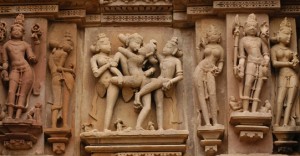
Even the term ‘sacred prostitution’ closes down, rather than opens up room for debate. As we’ve seen ‘prostitution’ is a highly loaded word and carries myriad connotations, all of which reinforce stigma. It has the effect of othering people who sell sexual services; it creates an ‘us’ and ‘them’. As Lizzie Smith argued, ‘the term “prostitute” does not simply mean a person who sells her or his sexual labour (although rarely used to describe men in sex work), but brings with it layers of “knowledge” about her worth, drug status, childhood, integrity, personal hygiene and sexual health’ (Smith, 2013). Framing ancient sexual practices within this stigmatised word is highly misleading as it transfers modern prejudices on to past institutions and distorts our reading.
The ancient Babylonian epic, Gilgamesh (circa 2100 BC) tells the story of a temple prostitute called Šamhat who serves Ishtar and tames the wild man Enkidu through her sexual skills. This is one of the earliest written references to sex work ever found, but it does not claim to be anything but a story. The earliest account of sacred prostitution in a nonfiction text is the Greek Historian Herodotus’ (484–c. 425 BC) account of sixth-century neo-Babylonia.
The foulest Babylonian custom is that which compels every woman of the land to sit in the temple of Aphrodite and have intercourse with some stranger at least once in her life. Many women who are rich and proud and disdain to mingle with the rest, drive to the temple in covered carriages drawn by teams, and stand there with a great retinue of attendants. But most sit down in the sacred plot of Aphrodite, with crowns of cord on their heads; there is a great multitude of women coming and going; passages marked by line run every way through the crowd, by which the men pass and make their choice. Once a woman has taken her place there, she does not go away to her home before some stranger has cast money into her lap, and had intercourse with her outside the temple; but while he casts the money, he must say, “I invite you in the name of Mylitta”. It does not matter what sum the money is; the woman will never refuse, for that would be a sin, the money being by this act made sacred. So she follows the first man who casts it and rejects no one. After their intercourse, having discharged her sacred duty to the goddess, she goes away to her home; and thereafter there is no bribe however great that will get her. So then the women that are fair and tall are soon free to depart, but the uncomely have long to wait because they cannot fulfil the law; for some of them remain for three years, or four. There is a custom like this in some parts of Cyprus (Histories, 1).
Herodotus is what might be politely termed an ‘unreliable narrator’. He is a historian in much the same way as Disney is a historian. What’s more, he is clearly out to smear the reputation of the Babylonians and is projecting his own negative views around sex onto history – so, is any of this true? We don’t know. His account is not corroborated with any independent sources (not even the ancient Babylonian ones.) But, other accounts of similar customs do exist (but they well may have been rehashing of Herodotus.) Four hundred years after Herodotus, the historian Strabo describes a ritual sexual activity practised at Acilisene in Armenia. Here, people honoured the Persian goddess Anaitis by dedicating their daughters to serve her in the temple before they were given in marriage.
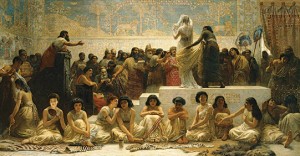
In De Dea Syria, Greek writer Lucian of Samosata (125 CE –180 CE) describes a ritual practised in Syria where women would have to have sex with a stranger in a public place as an offering of payment to the goddess Aphrodite (Lucian, De Dea Syria). The Augustan historian Pompeius Trogus wrote ‘There was a custom among Cyprians to send their virgins to the sea-shore before marriage on fixed days, for employment in order to get dowry-money, and to make a first-fruit offering to Aphrodite, a dedication to preserve their virtue in the future’ (Pompeius Trogus, Justin). There are several references in the Old Testament to “Qadeshes,” a word many have translated to mean female and male cult practitioners. Professor Gernot Wilhelm discovered a 3,300-year-old document that details a father selling his own daughter to the Temple of Ishtar to serve as a Harimtu. No details are given to the nature of work the girl was expected to do, but Wilhelm suggests it was sacred prostitution (Gernot, 1994). But, none of this makes establishing fact any easier.
I started this article by pointing how limiting it is to try look for modern equivalents in ancient sex practices; sex work is not the oldest profession because professions aren’t actually that old. In the same way that the loaded word ‘prostitute’ speaks to modern stigma and very specific narratives around sexual exchange, it’s not the right word to try and understand religious sexual practice. If we’re looking for a temple ‘prostitutes’, we’re looking for the wrong thing. ‘Sex worker’ also isn’t the right term either as that speaks to the professionalism of selling sexual service, rather than erotic spiritualism and worship through sex. Perhaps we need to stop trying to fit past sexual practices into prejudged categories we feel more familiar with. Take, for example, the 800-year-old Hindu tradition of the Devadasi.
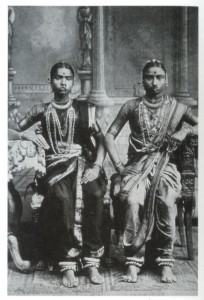
Devadasi means ‘female servant of God’ and they are women who are dedicated to the Goddess Yellamma. The earliest written records of dancing temple girls called Devadasi dates to 1230 – 1240 A.D., from the time of Raja Raya III in Maharashtra (B., Sharma and Raghavacharya, 1961). A thousand-year-old inscription in Tanjor Temple lists 400 devadasis in Tanjor, 450 in Brahideswara temple and another 500 in the Sorti Somnath temple (Spring, 1997). Devadasi looked after the temples, they sang and danced in devotion to the deities. They were also courtesans and supported by wealthy patrons who sought out the Devadasi because they were sacred women. They dazzled the courts with their poetry, music and devotion to the Goddess. Classical Indian dances such as Bharatnatyam, Odissi, and Kathak are all legacies of the Devadasi. Sex was a part of their world, but it was incidental; they celebrated art, beauty, love, and the divine. When the British colonised India, they brought with them their rigid world view and were unable to see the Devadasi as anything but ‘prostitutes’. We’ve seen what is associated with that word and all that was then projected on to the Devadasi. So repulsed were they by what they saw, the British set about shaming and dismantling the Devadasi institution.
In 1892, the Hindu Social Reform Association petitioned the Governor General of India and to the Governor of Madras to erase the Devadasi; ‘There exists in the Indian community a class of women community commonly known as nautch-girls. And that these women are invariably prostitutes’ (Jamanadas, 2007). The British missionaries taught India what a ‘prostitute’ was and why it was so shameful. Support for the Devadasi disappeared, they were socially shunned and stigmatised. Cut off from patrons and the temple, they tried to earn money by dancing at private events and selling sexual services. Eventually, the Devadasi was outlawed throughout India in 1988. The tradition continues in southern India, but the women are no longer respected. Now they are criminalised, stigmatised and without protection, many abuses occur and impoverished parents dedicate young daughters to the service of the Goddess. You see how powerful and damaging the word ‘prostitute’ can be?
Selling sex is not the oldest profession in the world, but it might be the oldest currency in the world. What’s more, trading on our sexuality is a basic human instinct and is witnessed in all human interactions. We’ve always had sex, always enjoyed sex and therefore always traded sex. Trading sex isn’t even unique to humans, but turning it into a profession and then judging it is certainly unique to humans. If we are to ever understand the history of selling sexual services, we need to move beyond modern stigma and unhelpful stereotypes. Sex work is a highly complex experience and always has been. If we approach the study of sex work from a position of hostility, if we do not allow sex workers to speak for themselves and shape the debate being had, all we will succeed in doing is perpetuating the prostitute mythology. Prostitution is not the oldest profession in the world, but it is a very old stigma indeed.
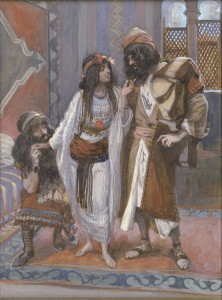
Text © Dr Kate Lister


